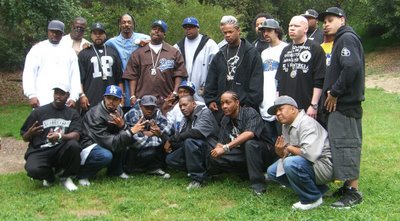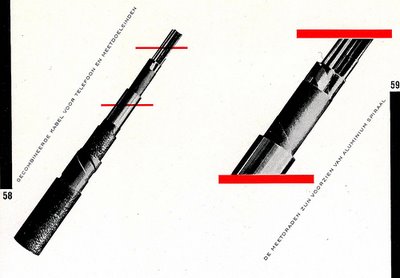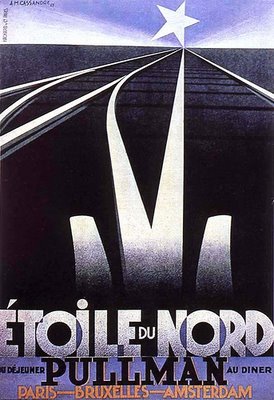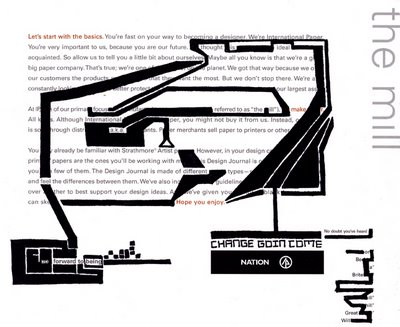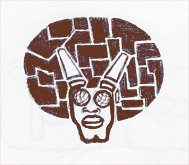Monday, December 04, 2006
Friday, December 01, 2006
Saturday, November 25, 2006
Wednesday, November 08, 2006
Tuesday, November 07, 2006
Monday, November 06, 2006
Sunday, November 05, 2006
Friday, October 27, 2006
Preach Ellen Lupton Preach!
The idea of skill has come to seem woefully outdated in an art world that emphasizes conceptual innovation, and making the right statement at the right time, with the right media. Gone are the days when life drawing was the backbone of any artists’ skill set. The term “skill” carries not only an academic connotation, but a working-class one. The skilled worker is one who knows something about a particular process (which puts him or her a step above the unskilled worker), but is not part of the professional class. Plumbers, auto mechanics and short-order cooks are skilled workers.
I’m arguing for the re-skilling of the American art student across the disciplines of fine and applied art, but working from our own design field as a model. Liberal arts education is based on the view that a certain body of knowledge is required to create a well-rounded person and an informed citizen of the world. The liberal arts ethos withdraws the pursuit of knowledge from the practical concerns of daily life; indeed, it views practical pressures as somehow tainting the purity of our educational goals.
That philosophy, of course, is under attack, and schools like New York University are actually encouraging liberal arts students to pursue professional internships during college (a practice unheard of a decade ago), and even to take “non-credit” workshops on such practical subjects as “graphic design.” The pressure for liberal arts programs to change comes from the customers: the students and their parents. Meanwhile, arts education offers a physically engaged, skill-based alternative to the liberal arts.
Skills
Conceptual skills: How to get ideas
Let’s demystify the notion of “conceptual thinking.” At the bottom, conceptual thinking is about getting ideas for a project: how to solve a problem, how to generate content, how to set the parameters of a project. Some students are good at this and some students are terrible, but there’s a lot we as educators can do to help them learn how to get ideas. This is where our work must begin. Thinking is not a mystery; it’s a skill.
Technical skills: How to realize ideas
Many educators, even in design, put technical skill at the bottom of their list of priorities. It’s not very glamorous or interesting to teach how to use software or make a comp. But technical training belongs right near the top because without technique, students are limited to primitive ways of realizing their work. So many of the art forms that have helped define the 20th century require a high level of technical proficiency: film, photography, video, design, architecture, animation. And yet faculty often looks down upon the teaching of technique. Oddly enough, technical skills are what many of our students want. Teachers would often rather spend a five-hour critique talking about “ideas,” while their students are hungry for technical knowledge.
Critical skills: How to build the discourse
We help students place their work in a historical and social context. Why do the fields of art and design function the way they do? What issues are artists and designers currently confronting in their work, and what’s the tradition against which contemporary practice takes place? This critical understanding helps students engage the world in a relevant way. The highest level of success for a designer or artist is, in my view, to create work that influences others in the field (or better yet, people in other fields). Such work contributes to the discourse.
Social skills:
How to work with people and make things happen
Social skills are harder to teach. There is no curriculum for showing students the importance of social interaction in the career of an artist or designer. You have to create situations where they can and must collaborate. I’m doing this in my graduate program at Maryland Institute College of Art by creating large-scale projects that rely on collaboration. Through these projects, the students witness the fact that big things are rarely done alone. It’s great preparation for the realities of the working world.
Professional skills: How to make a living
Last but not least: art schools need to prepare students for the working world. We need to show them how to document their work: record it, reproduce it, talk about it. Every student should leave school with a personal/professional website that they built themselves. They should all know how to write a resume, how to write a letter, how to write a proposal, and how to communicate effectively via email.
At the end of the day, a person who has successfully pursued these skills—conceptual, technical, critical, social and professional—is likely to be effective in many walks of life. The pursuit and cultivation of these skills may help students understand where their strengths and interests lie, and prepare them for a satisfying life in the working world.
Sacred Cows
In order to embrace a skill-based approach to art education, we have to question some of the sacred cows of the Art School.
Teaching art
The first one is “teaching art.” We don’t teach art; we teach art students. Art students are our customers. We have a serious obligation to them, and it is important to recognize their needs and desires in this new century, and not to be trapped in our views of what “art” is. A lot of teaching is focused more on the needs (and habits) of faculty than it is on the needs of our students.
The Critique
The old atelier model was to paint or draw in front of a live model for five hours while the professor wandered around making comments. That model was replaced by an even worse one: the critique, a five-hour discussion group where students talk about each other’s work, often pursuing a level of detail that far exceeds the intensity of the piece at hand. Students hate critiques, but in the post-skills studio environment, there is simply nothing else to do. Let’s use some of the time wasted in critiques to build skills.
Art enrichment
Art enrichment is over. It was the notion propagated in the 1950s that everyone should learn to understand and appreciate art, thus making people more sensitive and cultivated. This model still drives many museum education programs, as well as arts education in the schools, which is why art is the first subject to get cut. Enrichment is, by definition, a luxury. Today, people’s educational pursuits are more likely to be driven by practical and professional goals than spiritual enlightenment or “self improvement.” At the K-12 level, schools should be striving not to unleash a universal love for form and color, but to expose students to the properties and resistances of tools and materials, showing them how to solve problems and communicate visually and structurally. At the college level, programs for graduates, undergraduates, and post-graduates should think of the practical goals that drive people today towards higher education.
Responsibility towards our students
It is acceptable to say that we are preparing undergraduate students for “life in general,” but through an action- and skill-based course of study. But I believe we must be preparing graduate students to pursue sustaining creative work in their field of study. Although many of our graduates will not become “professional artists” within the gallery system, they should all leave school with a variety of concrete skills, skills that would be useful to a person in any path of life.
We can’t teach people to be geniuses (although, fortunately, our students are very, very talented), but we can teach them skills. It’s up to them to put those skills to work.
I’m arguing for the re-skilling of the American art student across the disciplines of fine and applied art, but working from our own design field as a model. Liberal arts education is based on the view that a certain body of knowledge is required to create a well-rounded person and an informed citizen of the world. The liberal arts ethos withdraws the pursuit of knowledge from the practical concerns of daily life; indeed, it views practical pressures as somehow tainting the purity of our educational goals.
That philosophy, of course, is under attack, and schools like New York University are actually encouraging liberal arts students to pursue professional internships during college (a practice unheard of a decade ago), and even to take “non-credit” workshops on such practical subjects as “graphic design.” The pressure for liberal arts programs to change comes from the customers: the students and their parents. Meanwhile, arts education offers a physically engaged, skill-based alternative to the liberal arts.
Skills
Conceptual skills: How to get ideas
Let’s demystify the notion of “conceptual thinking.” At the bottom, conceptual thinking is about getting ideas for a project: how to solve a problem, how to generate content, how to set the parameters of a project. Some students are good at this and some students are terrible, but there’s a lot we as educators can do to help them learn how to get ideas. This is where our work must begin. Thinking is not a mystery; it’s a skill.
Technical skills: How to realize ideas
Many educators, even in design, put technical skill at the bottom of their list of priorities. It’s not very glamorous or interesting to teach how to use software or make a comp. But technical training belongs right near the top because without technique, students are limited to primitive ways of realizing their work. So many of the art forms that have helped define the 20th century require a high level of technical proficiency: film, photography, video, design, architecture, animation. And yet faculty often looks down upon the teaching of technique. Oddly enough, technical skills are what many of our students want. Teachers would often rather spend a five-hour critique talking about “ideas,” while their students are hungry for technical knowledge.
Critical skills: How to build the discourse
We help students place their work in a historical and social context. Why do the fields of art and design function the way they do? What issues are artists and designers currently confronting in their work, and what’s the tradition against which contemporary practice takes place? This critical understanding helps students engage the world in a relevant way. The highest level of success for a designer or artist is, in my view, to create work that influences others in the field (or better yet, people in other fields). Such work contributes to the discourse.
Social skills:
How to work with people and make things happen
Social skills are harder to teach. There is no curriculum for showing students the importance of social interaction in the career of an artist or designer. You have to create situations where they can and must collaborate. I’m doing this in my graduate program at Maryland Institute College of Art by creating large-scale projects that rely on collaboration. Through these projects, the students witness the fact that big things are rarely done alone. It’s great preparation for the realities of the working world.
Professional skills: How to make a living
Last but not least: art schools need to prepare students for the working world. We need to show them how to document their work: record it, reproduce it, talk about it. Every student should leave school with a personal/professional website that they built themselves. They should all know how to write a resume, how to write a letter, how to write a proposal, and how to communicate effectively via email.
At the end of the day, a person who has successfully pursued these skills—conceptual, technical, critical, social and professional—is likely to be effective in many walks of life. The pursuit and cultivation of these skills may help students understand where their strengths and interests lie, and prepare them for a satisfying life in the working world.
Sacred Cows
In order to embrace a skill-based approach to art education, we have to question some of the sacred cows of the Art School.
Teaching art
The first one is “teaching art.” We don’t teach art; we teach art students. Art students are our customers. We have a serious obligation to them, and it is important to recognize their needs and desires in this new century, and not to be trapped in our views of what “art” is. A lot of teaching is focused more on the needs (and habits) of faculty than it is on the needs of our students.
The Critique
The old atelier model was to paint or draw in front of a live model for five hours while the professor wandered around making comments. That model was replaced by an even worse one: the critique, a five-hour discussion group where students talk about each other’s work, often pursuing a level of detail that far exceeds the intensity of the piece at hand. Students hate critiques, but in the post-skills studio environment, there is simply nothing else to do. Let’s use some of the time wasted in critiques to build skills.
Art enrichment
Art enrichment is over. It was the notion propagated in the 1950s that everyone should learn to understand and appreciate art, thus making people more sensitive and cultivated. This model still drives many museum education programs, as well as arts education in the schools, which is why art is the first subject to get cut. Enrichment is, by definition, a luxury. Today, people’s educational pursuits are more likely to be driven by practical and professional goals than spiritual enlightenment or “self improvement.” At the K-12 level, schools should be striving not to unleash a universal love for form and color, but to expose students to the properties and resistances of tools and materials, showing them how to solve problems and communicate visually and structurally. At the college level, programs for graduates, undergraduates, and post-graduates should think of the practical goals that drive people today towards higher education.
Responsibility towards our students
It is acceptable to say that we are preparing undergraduate students for “life in general,” but through an action- and skill-based course of study. But I believe we must be preparing graduate students to pursue sustaining creative work in their field of study. Although many of our graduates will not become “professional artists” within the gallery system, they should all leave school with a variety of concrete skills, skills that would be useful to a person in any path of life.
We can’t teach people to be geniuses (although, fortunately, our students are very, very talented), but we can teach them skills. It’s up to them to put those skills to work.
Thursday, October 26, 2006
Tibor Kalman Quote About Clients
“We’re not here to give them what’s safe and expedient. We’re not here to help eradicate everything of visual interest from the face of the earth. We’re here to make them think about design that’s dangerous and unpredictable. We’re here to inject art into commerce.”
Tuesday, October 24, 2006
Thursday, October 19, 2006
Friday, October 13, 2006
F.T.P. (N.W.A. Straight Outta Compton)
Well I've finally made it home. Yo, flying is not fun anymore! I remember when I was a kid going to the airport and getting on a plane was a stimulating event. It was an opportunity to see and meet different types of people and families from orther states and countries. Watch the latest film release and have all you can eat Honey Roasted Peanuts. Now, it feels like we are walking into a minimum security prison. Now, when one walks into the airport everyone looks either pissed or confused. People look as if they know they are being herded off to be slaughtered. There's one thing I can say for sure though, people are definitly making it a point to wear clean undamaged socks. For some reason I feel like i'm being forced to get to know everone in the airport personally, because all you see are people stripping and funky feet. The airport smells like a highschool lockerroom now.
Here's a random experience for you, since we're are talking about heightend airport security. When I was about 12 or 13 my brother and I were on are way back to L.A. from Detroit, ending our annual "Summer Trip." We had to take a connecting flight which stopped in St. Louis before connect to L.A.. While in St. Louis my brother and I were doing are usual walkabout, through the airport, whenever we had to stop in a connecting city. As we return to prepare to board the airplane a strange man who claims he's from airport security walks up to us and ask if we were alone? I responded with, "why do you want know," he says, "because you two fit the description of some kids who were reported missing, could you please step over here with me for a second," I responed with, "No, I don't know you." He then says, "Are you carrying any large amounts of money," I'm thinking to myself, "who is this fool," I am carried a bit of money, because whenever we go to to Detroit our family showers us with money to take back with us, so I respond, "yes", he tells me to show him, I guess what I showed him wasn't what he considered large amount of money because he immediately respondes with, " I'm sorry we made a mistake." So he and his crew turns around and walks off, when he turns I notice three letters on the back of his jacket, D.E.A. (Drug Enforcement Agency) This muthafucka thought I was a drug dealer. I was pissed all the way home. My brother was to young to understand what was going on, so it pissed me off even more to have to explain to him that we were just racially profiled as being 9 year old and 12 year old drug dealers and gang members. When I got home and explained the situation to my parents, my dad got pissed. Ever since then, I've had personal issue with cops, F.T.P.!
To end on a positive note, when I landed yesturday and saw my mother I gave her the biggest hug I could.
Over and Out,
R.E.A.L.I.T.Y.
Here's a random experience for you, since we're are talking about heightend airport security. When I was about 12 or 13 my brother and I were on are way back to L.A. from Detroit, ending our annual "Summer Trip." We had to take a connecting flight which stopped in St. Louis before connect to L.A.. While in St. Louis my brother and I were doing are usual walkabout, through the airport, whenever we had to stop in a connecting city. As we return to prepare to board the airplane a strange man who claims he's from airport security walks up to us and ask if we were alone? I responded with, "why do you want know," he says, "because you two fit the description of some kids who were reported missing, could you please step over here with me for a second," I responed with, "No, I don't know you." He then says, "Are you carrying any large amounts of money," I'm thinking to myself, "who is this fool," I am carried a bit of money, because whenever we go to to Detroit our family showers us with money to take back with us, so I respond, "yes", he tells me to show him, I guess what I showed him wasn't what he considered large amount of money because he immediately respondes with, " I'm sorry we made a mistake." So he and his crew turns around and walks off, when he turns I notice three letters on the back of his jacket, D.E.A. (Drug Enforcement Agency) This muthafucka thought I was a drug dealer. I was pissed all the way home. My brother was to young to understand what was going on, so it pissed me off even more to have to explain to him that we were just racially profiled as being 9 year old and 12 year old drug dealers and gang members. When I got home and explained the situation to my parents, my dad got pissed. Ever since then, I've had personal issue with cops, F.T.P.!
To end on a positive note, when I landed yesturday and saw my mother I gave her the biggest hug I could.
Over and Out,
R.E.A.L.I.T.Y.
Thursday, October 12, 2006
Tuesday, October 10, 2006
Monday, October 09, 2006
Saturday, October 07, 2006
Friday, October 06, 2006
Thursday, October 05, 2006
Wednesday, October 04, 2006
Going Back Cali, Cali, Cali........ (8 days Left)
Wednesday, September 27, 2006
Tuesday, September 26, 2006
Sunday, September 24, 2006
Tuesday, September 19, 2006
Interesting Article about the role of a Graphic Designer.
Does graphic design really make a difference?
(18) Comments By Dyske Suematsu
It’s nice to think our work can change the world, but is that really the case?
In my view, there is a fundamental misunderstanding in our society about what graphic design is. Here is an interesting observation by Ludwig Wittgenstein to illustrate this point: “Often, when I have had a picture well framed or have hung it in the right surroundings, I have caught myself feeling as proud as if I had painted it myself.” This is the most common pitfall of graphic designers. Since our work is often viewed by thousands or even millions of people, we become proud of our work as if the message was our own.
Fooling ourselves to believe that we are greater than what we actually are, cheapens the value of graphic design. We would have a better chance of making a real contribution to the world if we did not have a delusion of grandeur about it. The real value of graphic design cannot be realized if we misunderstand what it is.
Here is a personal story to illustrate this point: Years ago, I was at a small take-out restaurant in the Flatiron district of Manhattan. Though there was no fancy logo, sign, or window display, the place was quite busy. I ordered fish and chips, and when it was done, the man behind the counter, whose face was covered with grease and sweat, offered me a special sauce. The way he so proudly presented his sauce deeply touched my heart and I’ve never forgotten it since. As I thanked him for the sauce, I thought to myself, “I wouldn’t last a day behind this counter.” I could not imagine how this man was able to work there every day, and still find joy in offering his sauce. He seemed to possess an infinite capacity to be happy. In comparison, I felt like a spoiled brat. This man clearly had no expectation of changing the world. He had no delusion of grandeur about his job. Yet, he was able to touch my heart with his love for food and people, and became a source of inspiration for me.
In comparing our profession to others, it might be tempting, for instance, to compare graphic designers to architects, but the latter have a higher degree of fusion between form and content. There are of course many exceptions, but most great architects are responsible for the content of their own work. For example, the socio-political philosophies of Peter Eisenman and Rem Koolhaas are a significant part of what they sell and what their clients expect from them. In contrast, most graphic designers work hand-in-hand with others who create the content, such as advertisers, writers (books), musicians (album covers), and business owners (branding). If you are a graphic designer working for Greenpeace, the message behind your work is not yours. You may have a philosophy about how a certain type of message can be delivered more effectively, but that is independent of the message itself. The message does not originate in the designer. Architects on the other hand, deal with both types of philosophy.
A better comparison would be architectural engineers to graphic designers. However, most graphic designers would find this insulting. We want to believe that we are not just craftsmen or technicians, and that we have important things of our own to say. The field of graphic design attracts people with big egos because it is a business with high exposure. In fact, it is a business of high exposure, period. Because of that, it also attracts people who like to believe that they can change the world. Or, perhaps the process is the other way around. People who are interested in changing the world are naturally interested in communication, and so if they keep at it, they eventually become very good at it, which in turn leads them to apply their skills professionally.
Don’t get me wrong; I like graphic design, and I enjoy my work, but I don’t want to be confused about what it is. As a baker, you cannot expect to change the world, but that does not mean that baker is an irrelevant occupation. Bakers do make a difference in the world, but that cannot be the expectation of a baker. In fact, having no such expectation would work better towards making a real difference.
Graphic design is a noble occupation with a real purpose, but for that purpose to be realized, we need to see graphic design for what it actually is, and have certain humility about it. Graphic design is a supporting role, not a leading role. Musicians understand and appreciate better the value of being in supporting roles. If every player in a band tried to be a star, it would create a musical disaster. Not everyone is destined to be a star, and for someone to be a star, there must be others who are willing to play the supporting roles.
Graphic design is misleading in that it looks like a leading role, when in fact it is a supporting role. If one wants to play a leading role, one should learn to play violin instead of playing viola very loudly in order to be noticed. Otherwise, one will end up giving the viola a bad name.
(18) Comments By Dyske Suematsu
It’s nice to think our work can change the world, but is that really the case?
In my view, there is a fundamental misunderstanding in our society about what graphic design is. Here is an interesting observation by Ludwig Wittgenstein to illustrate this point: “Often, when I have had a picture well framed or have hung it in the right surroundings, I have caught myself feeling as proud as if I had painted it myself.” This is the most common pitfall of graphic designers. Since our work is often viewed by thousands or even millions of people, we become proud of our work as if the message was our own.
Fooling ourselves to believe that we are greater than what we actually are, cheapens the value of graphic design. We would have a better chance of making a real contribution to the world if we did not have a delusion of grandeur about it. The real value of graphic design cannot be realized if we misunderstand what it is.
Here is a personal story to illustrate this point: Years ago, I was at a small take-out restaurant in the Flatiron district of Manhattan. Though there was no fancy logo, sign, or window display, the place was quite busy. I ordered fish and chips, and when it was done, the man behind the counter, whose face was covered with grease and sweat, offered me a special sauce. The way he so proudly presented his sauce deeply touched my heart and I’ve never forgotten it since. As I thanked him for the sauce, I thought to myself, “I wouldn’t last a day behind this counter.” I could not imagine how this man was able to work there every day, and still find joy in offering his sauce. He seemed to possess an infinite capacity to be happy. In comparison, I felt like a spoiled brat. This man clearly had no expectation of changing the world. He had no delusion of grandeur about his job. Yet, he was able to touch my heart with his love for food and people, and became a source of inspiration for me.
In comparing our profession to others, it might be tempting, for instance, to compare graphic designers to architects, but the latter have a higher degree of fusion between form and content. There are of course many exceptions, but most great architects are responsible for the content of their own work. For example, the socio-political philosophies of Peter Eisenman and Rem Koolhaas are a significant part of what they sell and what their clients expect from them. In contrast, most graphic designers work hand-in-hand with others who create the content, such as advertisers, writers (books), musicians (album covers), and business owners (branding). If you are a graphic designer working for Greenpeace, the message behind your work is not yours. You may have a philosophy about how a certain type of message can be delivered more effectively, but that is independent of the message itself. The message does not originate in the designer. Architects on the other hand, deal with both types of philosophy.
A better comparison would be architectural engineers to graphic designers. However, most graphic designers would find this insulting. We want to believe that we are not just craftsmen or technicians, and that we have important things of our own to say. The field of graphic design attracts people with big egos because it is a business with high exposure. In fact, it is a business of high exposure, period. Because of that, it also attracts people who like to believe that they can change the world. Or, perhaps the process is the other way around. People who are interested in changing the world are naturally interested in communication, and so if they keep at it, they eventually become very good at it, which in turn leads them to apply their skills professionally.
Don’t get me wrong; I like graphic design, and I enjoy my work, but I don’t want to be confused about what it is. As a baker, you cannot expect to change the world, but that does not mean that baker is an irrelevant occupation. Bakers do make a difference in the world, but that cannot be the expectation of a baker. In fact, having no such expectation would work better towards making a real difference.
Graphic design is a noble occupation with a real purpose, but for that purpose to be realized, we need to see graphic design for what it actually is, and have certain humility about it. Graphic design is a supporting role, not a leading role. Musicians understand and appreciate better the value of being in supporting roles. If every player in a band tried to be a star, it would create a musical disaster. Not everyone is destined to be a star, and for someone to be a star, there must be others who are willing to play the supporting roles.
Graphic design is misleading in that it looks like a leading role, when in fact it is a supporting role. If one wants to play a leading role, one should learn to play violin instead of playing viola very loudly in order to be noticed. Otherwise, one will end up giving the viola a bad name.
Monday, September 11, 2006
What is good graphic design?
What makes a good graphic designer, and how can you be sure of getting good graphic design? The graphic design market can be confusing. At first sight, inexpensive graphic design looks readily obtainable, because there are a lot of good people out there eager to get some references. But for the customer, getting the right graphic design is not easy. In fact it's a problem. Because what is the right graphic design?
Just because someone can work with Photoshop or has a graphic design qualification does not necessarily mean they are a good designer. An able designer needs far more qualities than just a good eye for colour, form and detail. Design is an entity.
Good graphic design tells a visual story. Good graphic design employs succinct psychological tools, such as reactions to and associations with forms and colours. But above all, good graphic design is a visual expression that functions in optimised interaction with communication and strategy. This makes heavy demands on the designer's ability to integrate design into the whole. It also calls for considerable insight into the customer's firm, the purpose of the message and the underlying strategic thinking. Because like communication, design must reflect the customer's profile, appeal to the customer's buyers/partners, and also distance the customer from his competitors.
A good designer must therefore be able to be creative within the framework laid down by the customer. Bubbling creativity is of no use without a sense of context and economic realism. A designer must be capable of focused working within financial and time limitations. This is the challenge, and it is one of the areas a good designer gets paid to master.
That the designer must work within the framework of the customer's situation and market can surprise no one. But this does not mean it is the customer who sets the limits. The customer possesses an in-depth insight into the circumstances of his business. But precisely because he is so deeply involved it is important that fresh eyes should be brought to bear.
Innovation is a word commonly used in the value sets of many companies. But being innovative means being willing to move boundaries – not least within oneself. There is a difference between being creative and being innovative. Being creative means getting the best out of the given framework. This can be done by any good designer. Being innovative means thinking beyond the given boundaries to take a fresh look and set new boundaries. This takes courage and trust – on the part of both customer and designer. The best graphic design is therefore produced by a designer who knows the key questions to ask the customer and who transcends the conventional, and by a customer who has confidence in the end-result, dares to break limits – and to invest in the future.
Creativity, inspiration and above all motivation must never be forgotten. Because being a good graphic designer means being thoroughly tuned in, finding inspiration in the oddest things, and preferably also having access to exactly the right sources. An awareness of current and future trends is thus an integral part of a graphic designer's toolbox. This awareness provides the source of the inspiration that the designer passes on to the customer, but is also enables the designer himself to achieve self-renewal and find fresh creativity.
It should be clearly understood that a professional graphic designer does not necessarily have his own style. This is because the designer's job is to supply a message that has to fit the company's view of itself, the company's strategy, and the company's desired market position. Another reason is that the design must appeal to the values of the users. Good design must be design that works: design that helps generate revenue and optimise the understanding of the message. Such design can only result from thorough preparation, an analytical appreciation of the company's message and market, and naturally a creative mind.
By Jan Nielsen, Creative Manager, and Mette Falk, Graphic Designer, Kühl+co
Just because someone can work with Photoshop or has a graphic design qualification does not necessarily mean they are a good designer. An able designer needs far more qualities than just a good eye for colour, form and detail. Design is an entity.
Good graphic design tells a visual story. Good graphic design employs succinct psychological tools, such as reactions to and associations with forms and colours. But above all, good graphic design is a visual expression that functions in optimised interaction with communication and strategy. This makes heavy demands on the designer's ability to integrate design into the whole. It also calls for considerable insight into the customer's firm, the purpose of the message and the underlying strategic thinking. Because like communication, design must reflect the customer's profile, appeal to the customer's buyers/partners, and also distance the customer from his competitors.
A good designer must therefore be able to be creative within the framework laid down by the customer. Bubbling creativity is of no use without a sense of context and economic realism. A designer must be capable of focused working within financial and time limitations. This is the challenge, and it is one of the areas a good designer gets paid to master.
That the designer must work within the framework of the customer's situation and market can surprise no one. But this does not mean it is the customer who sets the limits. The customer possesses an in-depth insight into the circumstances of his business. But precisely because he is so deeply involved it is important that fresh eyes should be brought to bear.
Innovation is a word commonly used in the value sets of many companies. But being innovative means being willing to move boundaries – not least within oneself. There is a difference between being creative and being innovative. Being creative means getting the best out of the given framework. This can be done by any good designer. Being innovative means thinking beyond the given boundaries to take a fresh look and set new boundaries. This takes courage and trust – on the part of both customer and designer. The best graphic design is therefore produced by a designer who knows the key questions to ask the customer and who transcends the conventional, and by a customer who has confidence in the end-result, dares to break limits – and to invest in the future.
Creativity, inspiration and above all motivation must never be forgotten. Because being a good graphic designer means being thoroughly tuned in, finding inspiration in the oddest things, and preferably also having access to exactly the right sources. An awareness of current and future trends is thus an integral part of a graphic designer's toolbox. This awareness provides the source of the inspiration that the designer passes on to the customer, but is also enables the designer himself to achieve self-renewal and find fresh creativity.
It should be clearly understood that a professional graphic designer does not necessarily have his own style. This is because the designer's job is to supply a message that has to fit the company's view of itself, the company's strategy, and the company's desired market position. Another reason is that the design must appeal to the values of the users. Good design must be design that works: design that helps generate revenue and optimise the understanding of the message. Such design can only result from thorough preparation, an analytical appreciation of the company's message and market, and naturally a creative mind.
By Jan Nielsen, Creative Manager, and Mette Falk, Graphic Designer, Kühl+co
Tuesday, August 29, 2006
Stop fondling your [EGO]TESTICAL SACK, and design!

"A designer with too much ego may forget that his/her work involves many people.................If communication among collaborators breaks down, if VANITY intrudes, the project suffers. A designer must welcome others into the effort; it is a social transaction." -MALCOM GREAR
Why are so many young designers afraid of or shy away from designing with others? Why do so many designers forget that it's those "others" that feed the creative process?
Young designers today are so selfish, they want to take but they don't want to give. They want to take all the applause, but will not return the applause. They want to be known as the famous originator, the innovator, but forget the fact that all that fame is the result of one's ability to draw from "other" processes.
Is this generation so caught up in the "Celebreality Lifeshow" that they will intentionally isolate themselves and their design process out of fear that someone else may recieve more pats on the back? Are they afraid that someone else may steal their light (bling)? Are they fearful that someone else may draw from their idea and make it better, what's wrong with improvement/change? What is it with designers today and this need to be a celebrity? So many lose sight of the fact that good design is NOT the result of a self-indulgent solo process. Good design communicates to all, and therefore, draws from all.
Good visual communication is the result of good collaberation, with designers, family, friends, society, the world. A good designer draws from their personal experiences, the experiences of others, nature, history, coincidences, illustrations, photographs, children, friends, family, printers, poems, design. Do you really think good design is the result of isolation, fear, vanity, explotation, doubt, insecurities, etc.? How do you expect to communicate to the people if you don't interact with those that you call yourself communicating too?
Get off your EGOTESTICAL SACK, this is not about autographs, praise, fame, applause, points or any of that ephemeral superficial bullshit. This is about CREATIVE VISUAL COMMUNICATION. (period!)
-R.E.A.L.I.T.Y.
over, and out!
Saturday, August 26, 2006
It Begins!

I found this logo while looking through a Logolounge book. The book gave a short description of the logo's beginings and the reason the city of Hong Kong decided to brand it's city in today's brand saturated market. I found this to be very helpful in giving me an idea of what the standards are for branding anything, especially a major international landmark competing globally for proper respect and recognition. I will be doing more research concerning this but I think this will give me a great start.
-----------------------------------------------
I've also found some great logos from different international railway companies. These struck me as being the most charismatic and timeless logos of the list I researched.











Subscribe to:
Posts (Atom)














